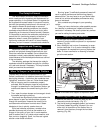
22
Vermont Castings Defiant
5. Close the damper when the griddle temperature
reaches 450°F (230˚C).
6. Adjust the air control for your desired heat
output.
ST264
Fig. 28 Add larger pieces of wood as the fire begins to burn
well.
NOTE: Stove installations vary widely, and the
operating guidance given here is only a starting point .
The draft management information on pages 24 will
explain in detail how the features of your installation
may help or hinder good draft, and how you may need
to vary your firing technique if your installation doesn't
encourage a good draft.
Refuel While the Embers Are Still Hot
When reloading, best results will be achieved if
you first de-ash the stove by stirring the fuel bed to
allow ash to fall through the grate into the ash pan.
Do not break the charcoal into very small pieces or
pound or compress the charcoal bed.
It is important that air can circulate through the
charcoal bed during the burn. Larger pieces of char-
coal allow more air to circulate under the wood,
resulting in the fire reviving more quickly. (Fig. 29)
ST264a
Fig. 29 Add full size logs aafter the ember bed is 3” (75mm)
deep.
For best results when refueling, wear long-cuffed
stove gloves to protect your hands and forearms, add
fuel while the stove still has plenty of glowing embers
to re-kindle the fire, and include some smaller pieces
of wood in the new fuel load to help the stove regain its
operating temperature quickly. Use this sequence as a
guide to successful refueling:
1. Open the damper.
2. De-ash the stove as described above. Open the
ashdoor and check the level of ash in the ash
pan. Empty the pan if necessary and replace it
in the stove. Close the ash door.
3. Open the griddle, load the wood (smaller pieces
first), and close the griddle.
4. Close the damper.
5. When the surface temperature reaches 450° F.
(230˚C), adjust the air control for the amount of
heat you desire.
NOTE: If the remaining charcoal bed is relatively
thick and if your fuel is well seasoned, it is possible to
add fresh fuel (smaller pieces first), close the door and
damper, and reset the primary air thermostat for the
desired heat output.
WARNING: OPERATE YOUR DEFIANT ONLY WITH
THE DOORS EITHER FULLY OPEN OR FULLY
CLOSED.
CAUTION: The Defiant will be hot while in
operation. Keep children, clothing and furniture
away. Contact may cause skin burns.
DO NOT OVERFIRE THIS HEATER. Overfiring
may cause a house fire, or can result in permanent
damage to the stove and to the catalytic combustor. If
any part of the Defiant other than the baffle and/or
catalytic combustor glows, you are overfiring.
The baffle is made of a special cast iron which can
withstand higher temperatures than most other parts of
your stove. It protects the catalytic element from direct
flame impingement, which can shorten the catalyst’s
life. Since the baffle is in the direct path of flame
between the firebox and the catalyst, it reaches higher
temperatures than other firebox parts, and it may glow
at times. If it does glow, you will see this directly
through the front doors. The glow is normal and does
not indicate a problem.
At times you may see a glow from the catalyst
shining
through
the ports of the baffle. This is also
normal and does not indicate a problem. The catalytic
element, located below and behind the baffle, can glow
at high temperatures. This is also normal. However, the
element can be active and operate properly without
glowing. The lack of a glow does not indicate that the
catalyst isn’t working. Note that the catalyst is most


















